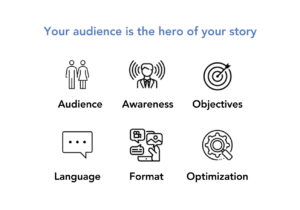
Delight your audiences as they move through the journey to purchase with creative that matches their intent, aligns with strategic insights.

Anyone from anywhere in the world can make content, but not everyone can create content that actually works or makes an impact on their target audience. The key is to speak with your audiences, not at them. By having a conversation and getting to know your audience, you will begin to understand what content brings you both together.
Creating the right content for your business is really about aligning your products and services with your audience’s needs and interests. Making your audience the hero of the content ensures that your message resonates, and by integrating how your business can help solve their individual challenges or provide opportunities, the content becomes more relevant and likely to engage.

In this story, what are their dreams, needs, and goals? Where do they spend their time online and offline, and what are their values? What drives brand affinity and what helps them make relevant purchasing decisions?
Are they brand new and needing more context? Are they familiar and need more detailed information to help them make a final decision? Or are they brand-loyal and in need of reasons to stay engaged? Creating a variety of content that helps meet the users where they are across the user journey is a step in the content creation process that should not be ignored.
Identifying how your value proposition applies to your audience will reveal your best opportunities to enter into conversations. Explore relevant topics that will help bridge your audience’s story with your own and, most importantly, provide them value along their journey.

Conduct SEO research that illuminates more about speaking your audience’s language—and we don’t just mean multilingual content. SEO keyword research allows brands to evaluate how users seek out information relative to their brand, service, or industry. Applying this research is essential in understanding not only what they are seeking, but how they’re asking for information or services around the topic.
Subscribe to our monthly newsletter.
How is this content being delivered within your audience’s omnichannel experience with your brand? From audience research, do we know if users prefer videos, social post content, or longer web articles? How users consume content should impact how we create for them. Impactful stories come to life in many ways, and planning the development of quality content ensures you have a variety to meet their needs on the website, on social media, or even through email.
There is little point to creating content just to create it. All content should be created with a purpose and goal, and should be measured accordingly. Identifying the goal of the content and assigning KPIs will tell you if your content is reaching your users and resonating with them. Have you determined the goal of your content yet? Consider what would count as a win for your piece—whether it’s engagement, click-through, follow, like, or even downloads or subscribes—and design your content and call-to-action in a way that helps users see how converting will help them meet their own goals and needs.
Keep in mind that visitors come to your brand looking for content. But all the other aspects of your site or page, such as the design and user interface, are essential too and complement your content to deliver something of high value and quality to your visitors.
Not sure where to start? Our Content Strategy team are here to help—and it all starts with a friendly chat. Let’s talk!
Delight your audiences as they move through the journey to purchase with creative that matches their intent, aligns with strategic insights.
Delight your audiences as they move through the journey to purchase with creative that matches their intent, aligns with strategic insights.
Subscribe to our monthly newsletter.